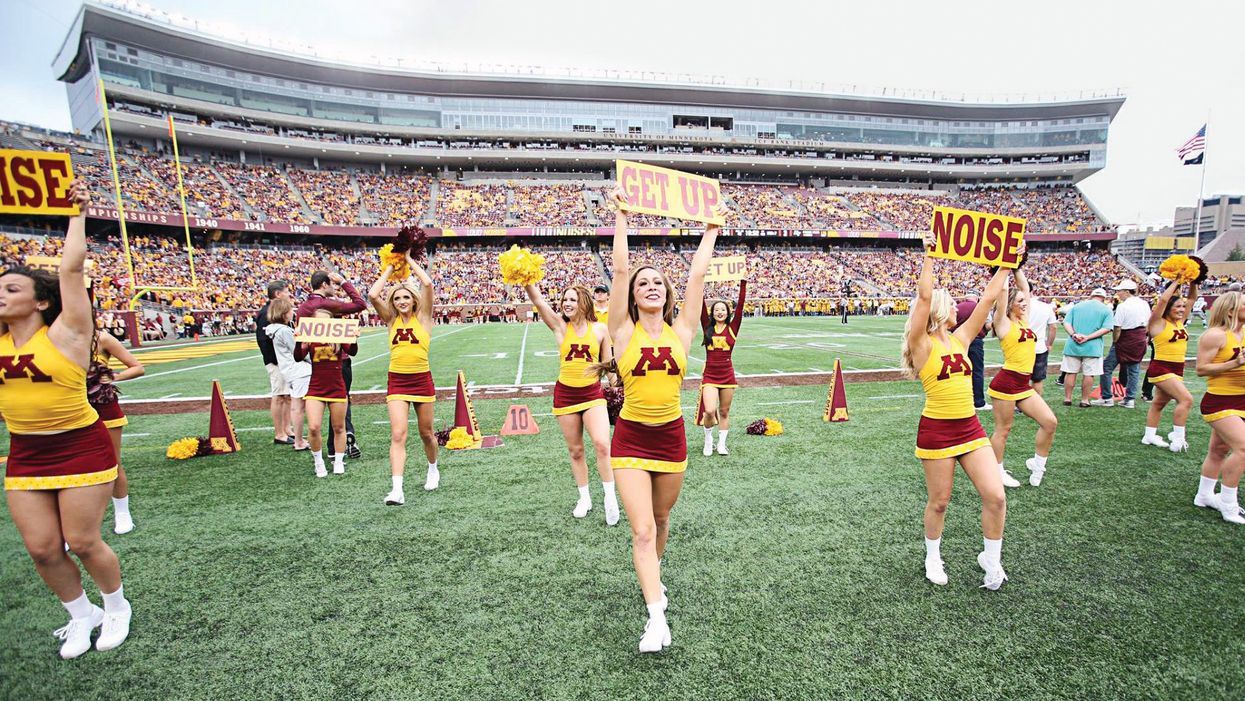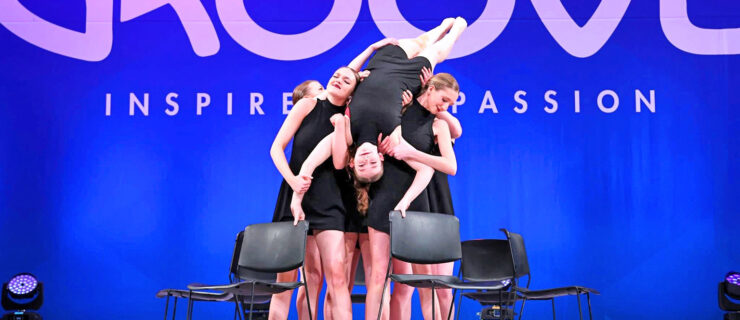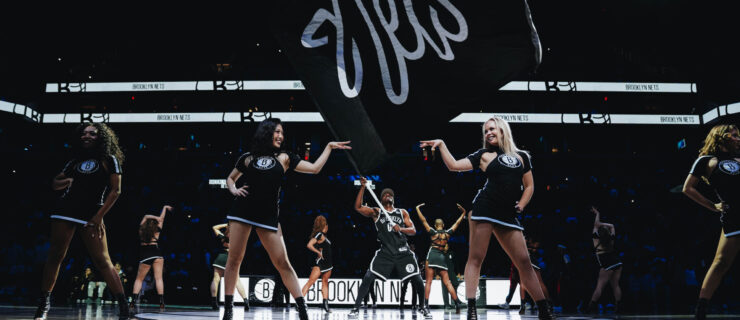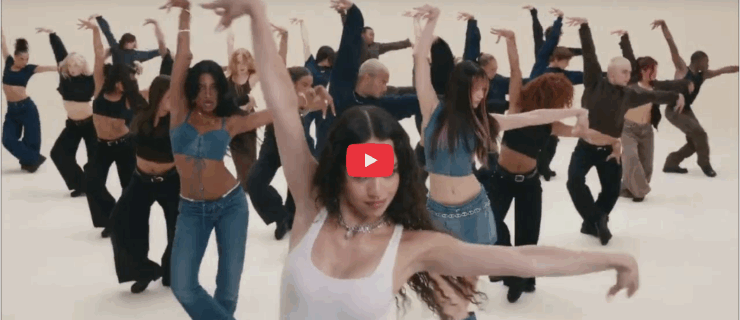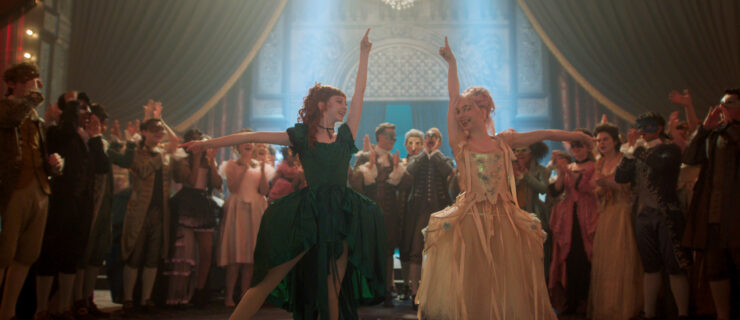The Best College Dance Teams in the Country—and What It Takes to Be on Them
They say there’s no “I” in “team”—and nowhere is that truer than the world of college dance teams, where precision reigns, uniformity is key, and a single misstep from any given “I” can cost a group a championship trophy. So it’s unsurprising that securing a spot on one of the best dance teams in the country is no easy feat.
Members of these highly athletic teams rehearse for hours every week—on top of academic classes and commitments—and perform at football and basketball games, annual concerts, and nationally televised competitions (hi, ESPN). And “no I” rule notwithstanding, each of these top teams is made up of highly trained, highly technical, highly hard-core individuals, who come together to create a ready-for-victory pack.
These six teams aren’t one-off success stories—they’re consistently strong, and earn the top spots at major competitions like UDA and NDA nearly every year. Up for the challenge? Here’s what to know before you go to auditions.
Brigham Young University Cougarettes
 Courtesy Brigham Young University
Courtesy Brigham Young University
Provo, UT
Where they perform:
At all BYU home basketball and football games, at the team’s concert every February, and at NDA Nationals every year. Between competitions, concerts, games, and other events, the Cougarettes perform more than 50 times every year.
What they’ve won:
16 national titles
When they rehearse:
Monday through Friday for a total of 12 hours; during concert week or before Nationals, this increases to up to 20 hours per week.
What makes them the best:
The Cougarettes are a long-standing institution at BYU. The team was founded in 1946, and has been led by coach Jodi Maxfield—a former Cougarette herself—for nearly 30 years. “I’ve tried to make sure the team remains true to our mission statement and expectations from our alumni and the university,” says Maxfield, referring to BYU’s affiliation with the Church of Jesus Christ of Latter Day Saints. “We are a spiritually based team, and there is a sisterhood that is a part of all we do, and we strive to convey that when we dance.” Plus, Maxfield brings in guest choreographers to set routines on the Cougarettes for competitions, including Tabitha and Napoleon D’umo, Shandon Perez, Karl Mundt, and
Jaci Royal. (The fact that the team’s mascot, Cosmo the Cougar, can join in and bust out the routines flawlessly doesn’t hurt—and has helped the team’s videos go viral twice over the past two years.)
What to know before you go:
Auditions are held annually in April for current and incoming students. “We’re looking for exquisite dancers who blend well together in the style of the Cougarettes,” Maxfield says. “We want people with incredible stage presence who are entertaining to watch. And our fans obviously love seeing turns and hip-hop tricks.”
Arizona State University Sun Devils
 Courtesy Arizona State University
Courtesy Arizona State University
Tempe, AZ
Where they perform:
At all home football games and both men’s and women’s basketball games during the pregame and halftime, and on the sidelines. Each year, the team performs at 13 football games, more than 50 basketball games, 2 to 3 marching band events, up to 75 community appearances and fundraising events, and one national competition (UDA).
What they’ve won:
The Sun Devils have consistently been ranked in the top 5 at College Dance Team National competitions, and are two-time ICA world champions.
When they rehearse:
During football season, the team practices three nights a week leading up to game days on Saturdays, which are a 10- to 12-hour commitment. During basketball season, practices are twice a week. Rehearsal times peak in November and December, when football and basketball seasons overlap with Nationals prep; during that time, the team practices up to seven days a week.
What makes them the best:
This team can turn. ASU is known for its impressive, highly technical turn sequences—something coach Bianca Caryl says can only happen with a team stacked with talent. “Many teams have several outstanding dancers who are featured and lead their group in technique and style,” Caryl says. “But every one of our dancers is well-trained.”
What to know before you go:
Auditions are held annually in April. Caryl is looking for dancers who can keep up with the team’s intense turn combinations: Dancers must be able to do five consistent, clean pirouettes, plus a side aerial. “But first and foremost, they must be strong entertainers,” Caryl says. “We’re looking for outstanding stage presence and ‘game-day poise.’ Anyone can be a robotic dancer who does the right tricks, turns, and choreography—but we’re looking for that wow factor.”
Towson University Dance Team
 Courtesy Kaitlyn McGuire/NDA
Courtesy Kaitlyn McGuire/NDA
Towson, MD
Where they perform:
At various football games, basketball games, area community events, and campus events, plus the team’s annual dance showcase and at NDA Nationals—in total, up to 30 performances per year. (But school comes first: Towson dancers are never allowed to miss an academic class for a dance team commitment.)
What they’ve won:
17 NDA national championships
When they rehearse:
Tuesdays and Thursdays from 3:30 to 6:30 pm, plus three weekend rehearsals per month
What makes them the best:
Hard work, clean routines, and great music. “Our work ethic really sets us apart from other teams,” says longtime Towson coach Tom Cascella. “There may be teams with better coaches, better dancers, better choreographers, better costumes—but there isn’t a dance team in the country that works and rehearses harder than we do.” (It’s not uncommon for incoming freshmen to tell Cascella that their first Towson rehearsal was more intense than all their high school rehearsals combined.) “You can’t purchase a national championship—it has to be earned,” Cascella says. Plus, Towson’s routines are frequently set to current, fun music that both the dancers and fans want to hear.
What to know before you go:
Auditions are held throughout the year, and Cascella is flexible when it comes to accommodating private auditions. The team also accepts video submissions as first-round auditions. Towson hopefuls are asked to perform technical skills (leaps, turns, jumps) and a solo of their choice before advancing to the callback round, which is structured like a rehearsal. “We’re looking for performers and dancers who want to work hard and not have everything handed to them,” says Cascella. “We’re a very diverse team. We have some members who never did pom until they joined the team, and others who had never done hip hop.”
Penn State Lionettes
 Courtesy Universal Event Photography
Courtesy Universal Event Photography
State College, PA
Where they perform:
The Lionettes perform 50 times a year at home football games, men’s and women’s home basketball games, community events like homecoming, and one national collegiate competition. (This year, for the first time, Penn State competed at UDA Nationals.)
What they’ve won:
NDA Division 1A collegiate national championship titles in 2012, 2013, and 2014
When they rehearse:
The team practices for 12 hours a week, not including team workouts and seven-hour weekend commitments for sporting events or additional practices.
What makes them the best:
Those jump splits. The Lionettes have stayed true to their roots—the team was originally a kickline team—by ending every routine with their signature synchronized jump splits.
What to know before you go:
The team holds auditions every spring, and accepts video auditions for those who can’t make the trip to State College. “We look for dancers with a strong technical foundation and versatility in their style and performance,” says coach Julie Berardi—the team’s first-ever coach. (The Lionettes were student-run from 1995 to 2015, when Berardi came on board.) Lionette hopefuls also do a personal interview, which Berardi says is one of the most important components of the audition process.
Stephen F. Austin State University Dance Team
 Courtesy Stephen F. Austin Dance Team
Courtesy Stephen F. Austin Dance Team
Nacogdoches, TX
Where they perform:
At all home football and basketball games, plus recruiting events, community performances, and NDA Nationals—totaling up to 60 performances each year
What they’ve won:
12 NDA collegiate national championships
When they rehearse:
For 8 to 10 hours a week, plus weekends as needed and parts of winter break and spring break
What makes them the best:
With 43 members—37 women and 6 men—Stephen F. Austin currently boasts one of the largest dance teams in the country. But even with so many dancers, the focus is on working together. “Just because someone is a great dancer with impeccable technique doesn’t mean they’re a good fit for our family,” says coach T.J. Maple. “I’m in the business of creating great people—winning national championships is just a bonus. Trophies collect dust, banners fade. But the type of people these dancers become and what they go through in the process is important to all of us.”
What to know before you go:
Auditions are held in May, and include across-the-floor sequences and improv sections. Each dancer must be able to do a quadruple pirouette, a side aerial, two 8-counts of fouettés, and a headspring.
University of Minnesota Dance Team
 Courtesy University of Minnesota
Courtesy University of Minnesota
Minneapolis, MN
Where they perform:
At home football games and men’s basketball games, plus one away football game each year, various basketball tournaments, and community-service events. The team competes at UDA Nationals and UDA’s college camp every summer, and hosts an annual “Best of the Best” performance showcase featuring top local high school and college teams.
What they’ve won:
18 UDA national titles (10 jazz, 8 pom)
When they rehearse:
Three days a week, plus additional rehearsals leading up to Nationals
What makes them the best:
They’re consistent, technical, and strong. Minnesota is known for its ability to execute difficult skills in perfect unison. The team is currently coached by three former captains—Rachel Saunders, Rachel Fellows, and Kimberly Saunders—who know exactly what it takes to become national champions. “Our program has been super-successful over the years, but with success comes pressure,” Rachel Saunders says. “These girls thrive under pressure, and really train their bodies and their minds for high-pressure situations. They stay humble and hungry to get better every year.”
What to know before you go:
Auditions are held annually in April. “Technique and a strong skill set are important, but most importantly, we look for dancers who are coachable,” says Saunders. “We want you to be yourself.”
More Teams To Watch
When it comes to national competitions, the top slots are always up for grabs. Here are a few other teams to keep your eye on.
University of Cincinnati Dance Team
University of Louisville Ladybirds
University of Memphis Spirit Squad
University of Missouri Golden Girls
University of Nevada, Las Vegas Rebel Girls
Ohio State University Dance Team
A version of this story appeared in the April 2018 issue of
Dance Spirit with the title “The Best College Dance Teams In The Country.”
